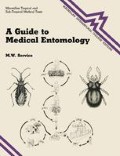Abstract
In entomological surveys after man-biting insects have been collected and identified it is often important to determine whether they are disease vectors; for example, whether anopheline mosquitoes caught feeding on man are vectors of malaria or filariasis, and if so the infective proportion.
Preview
Unable to display preview. Download preview PDF.
Bibliography
Baker, J. R. (1970) Chapter 4. ‘Techniques for the detection of trypanosome infections’, pp. 67— 88, in Mulligan, H. W. (ed.) The African Trypanosomiasis, ( George Allen amp; Unwin, London ), 950 pp.
Boreham, P. F. L. (1972) ‘Serological identification of arthropod bloodmeals and its application’, PANS, 18; 205–209.
Davies, H. (1977) Tsetse Flies in Nigeria, 3rd ed., ( Oxford Univ. Press., Ibadan ), 340 pp.
Weitz, B. G. F. (1970) Chapter 18. ‘Methods for identifying the blood meals of Glossina’, pp. 416–423, in Mulligan, H. W. (ed.). The African Trypanosomiasis, ( George Allen amp; Unwin, London ), 950 pp.
World Health Organization (1961) A Practical Guide for Malaria Entomologists in the African Region of WHO, (Wld Huth Org. Geneva), unpaginated.
World Health Organization (1975) Manual on PracticalEntomology in Malaria Part II, WHO Offset Publ. no. 13; 191 pp.
Copyright information
© 1980 M W Service
About this chapter
Cite this chapter
Service, M.W. (1980). Methods for dissecting arthropod vectors to determine infection rates. In: A Guide to Medical Entomology. Palgrave, London. https://doi.org/10.1007/978-1-349-16334-2_26
Download citation
DOI: https://doi.org/10.1007/978-1-349-16334-2_26
Publisher Name: Palgrave, London
Print ISBN: 978-0-333-23382-5
Online ISBN: 978-1-349-16334-2
eBook Packages: Biomedical and Life SciencesBiomedical and Life Sciences (R0)

